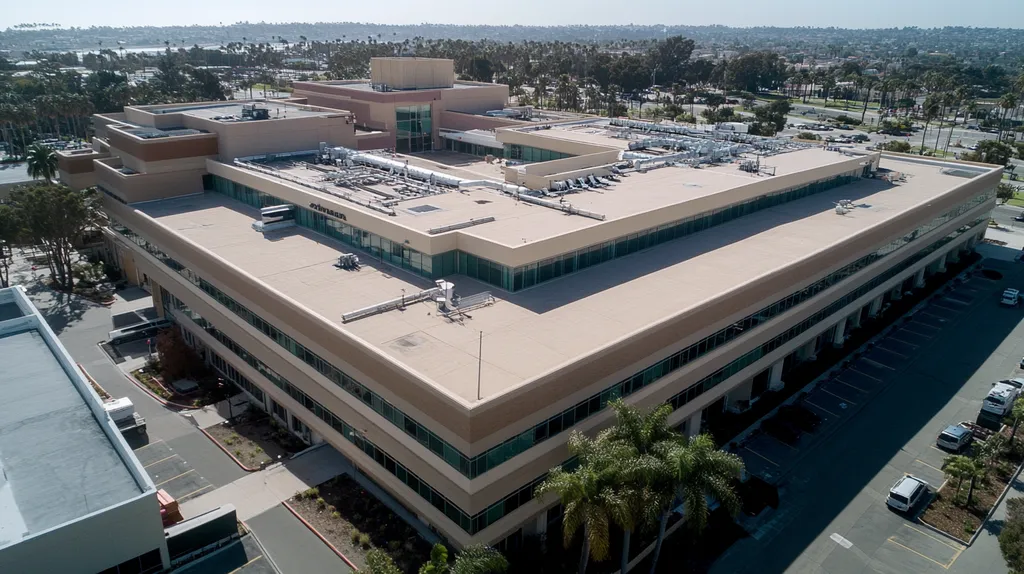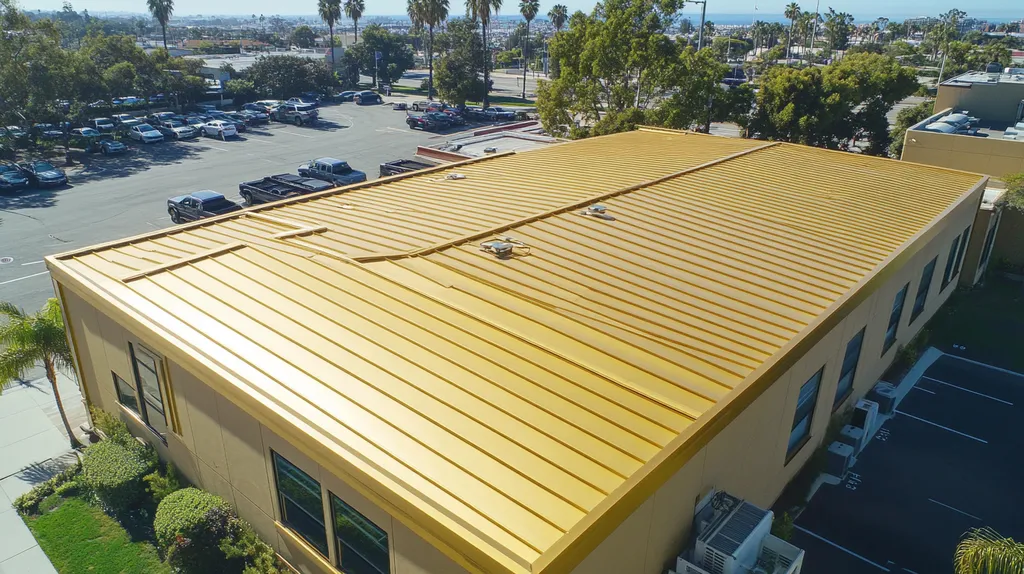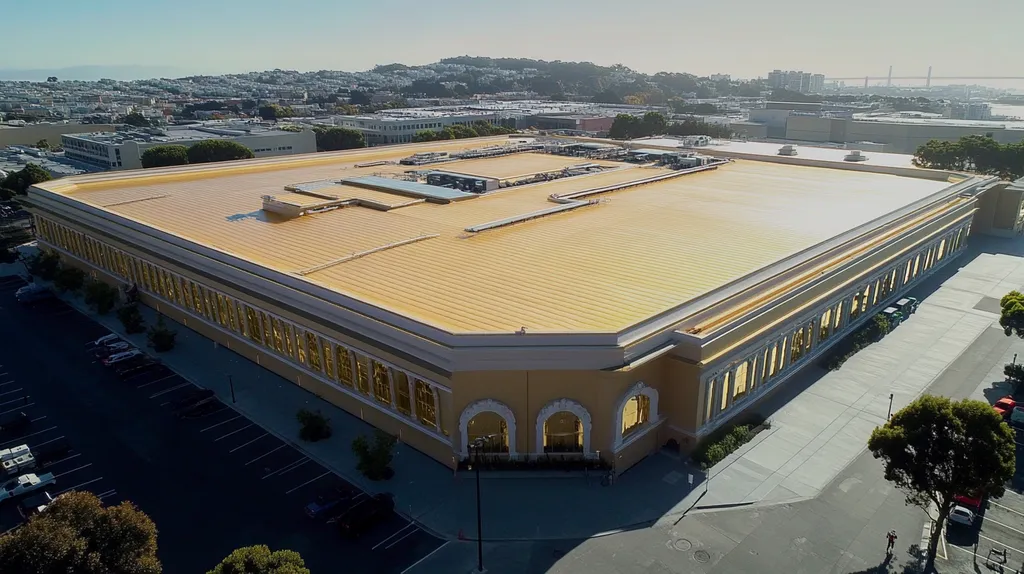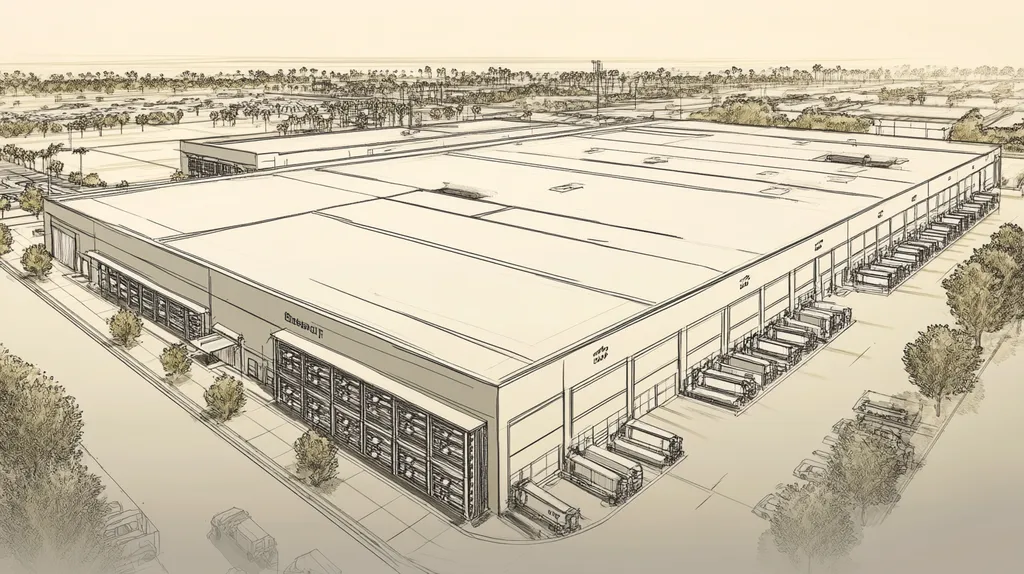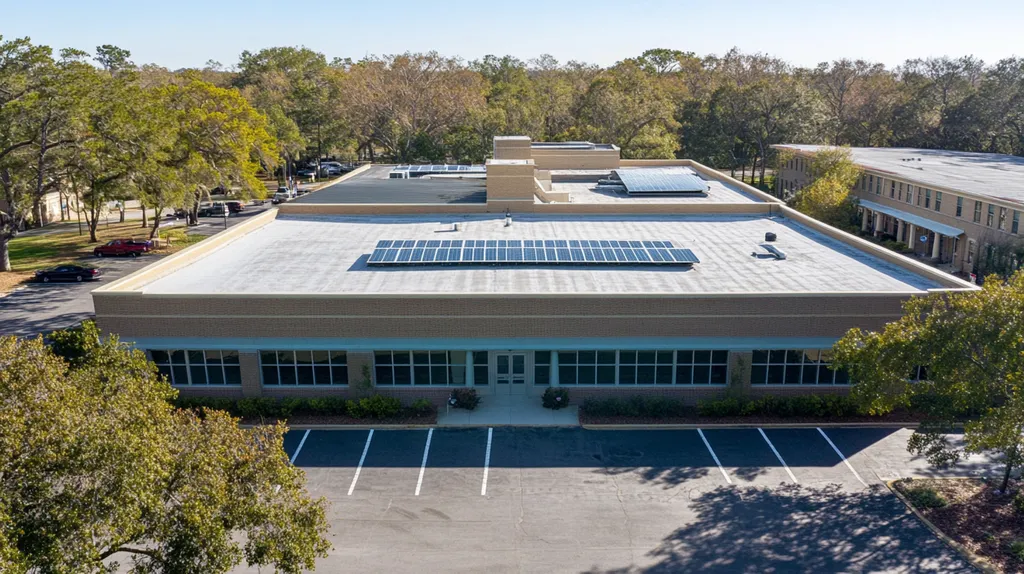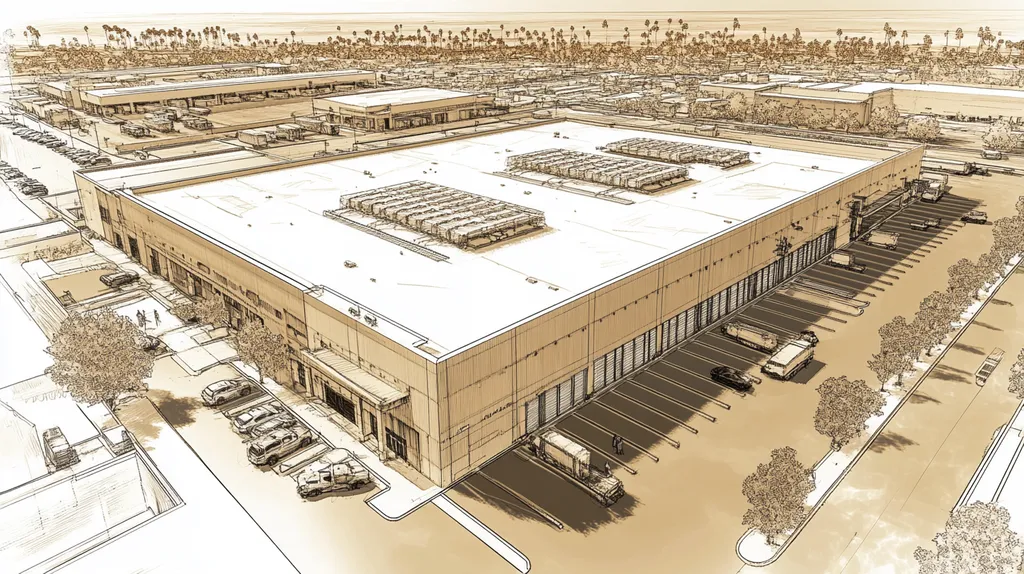Commercial property owners lose millions annually due to roofing misconceptions that lead to premature replacements and emergency repairs. Industry data shows that 30% of commercial roofs are replaced years before necessary, while proper maintenance could extend their lifespan by decades.
From drainage myths to inadequate inspection schedules, these costly misunderstandings continue to strain maintenance budgets and compromise building integrity.
This comprehensive guide examines common roofing fallacies, their practical implications, and evidence-based solutions that can help property owners make informed decisions while minimizing long-term expenses.
SECTION 1: COMMON MISCONCEPTIONS
Many commercial property owners hold the mistaken belief that minor leaks in their roofs are trivial. This can be a dangerous oversight, as neglecting these leaks can lead to severe damage, mounting repair costs, and even health risks from mold growth. To protect their investments and ensure the longevity of their roofing systems, it’s essential to dispel these common myths. This section will delve into misconceptions about minor leaks, the drainage needs of flat roofs, and the reality behind patching solutions.
Ignoring Minor Leaks
One of the most prevalent misconceptions is the idea that minor leaks are inconsequential. Property owners often believe a small drip won’t cause harm, but this is a critical error. Even minor leaks can quickly escalate into substantial water infiltration, leading to extensive damage inside a building and jeopardizing its structural integrity.
When small leaks are ignored, moisture can infiltrate walls, insulation, and electrical systems, resulting in remediation costs that can far exceed the price of timely repairs. Furthermore, prolonged moisture exposure increases the risk of mold growth, creating a potential health hazard for occupants.
Acting promptly to repair minor leaks can save property owners significant amounts of money. Regular roof inspections and proactive maintenance can catch these issues early, preventing them from turning into major problems. Recognizing the importance of immediate action for leak management is essential for effective building maintenance.
By treating minor leaks with the seriousness they deserve, property owners can foster a healthier environment for occupants and keep long-term expenses in check. Proactive leak management not only improves the overall performance of roofs but also enhances their lifespan.
Flat Roofs and Drainage Myths
Another common myth about commercial roofing is the belief that flat roofs do not require effective drainage. This misconception can be severely damaging, as inadequate drainage leads to water pooling, which accelerates roof deterioration. In reality, flat roofs need to be equipped with appropriate slopes and drainage solutions to manage water efficiently.
Pooling water adds excessive weight to a roof, posing risks of sagging and leaks. Moreover, standing water can degrade roofing materials and promote the growth of algae and moss, further undermining the roof’s integrity.
Investing in a robust drainage system is essential for extending the life of flat roofs. Features like scuppers, roof drains, and proper slopes can prevent water accumulation. Property owners should carefully evaluate their roof designs to ensure they are conducive to effective water management.
Understanding that flat roofs require as much attention to drainage as sloped roofs is crucial. By correcting this misconception, property owners can take proactive steps to protect their investments and enhance the lifespan of their roofing systems.
Patching as a Permanent Fix
Many building owners mistakenly believe that patching a roof leak provides a permanent solution. While patching might temporarily mask the issue, it fails to address the root causes of the leak. Over time, patched areas can deteriorate, leading to recurring leaks and costly repairs.
A patch should be considered a temporary measure. For lasting results, property owners must assess their entire roof system and contemplate more comprehensive repairs or replacements when necessary. Continually relying on patches can trap owners in a cycle of short-term fixes that ultimately waste money.
Moreover, neglecting the underlying causes of leaks can precipitate widespread roof failures. A proactive approach involving regular maintenance and inspections is critical to identify issues before they escalate. Relying solely on patches without further action is not a sustainable strategy.
Understanding the limitations of patching is vital for effective roof management. Property owners should focus on durable solutions that tackle problems head-on, rather than merely treating the symptoms in their roofing systems.
SECTION 2: PRACTICAL IMPLICATIONS
The choices made regarding commercial roofing can significantly impact a building’s lifespan and operating expenses. Alarmingly, 25% of commercial roofs are replaced prematurely due to inadequate maintenance and planning. Property owners must grasp how their decisions regarding roof upkeep can influence longevity, structural integrity, and energy costs to avoid unforeseen expenses.
Impact on Roof Lifespan
A roof’s lifespan plays a crucial role in a building’s financial well-being. While many commercial roofs are engineered to last for 20 years or more, neglecting routine maintenance can drastically shorten this timeline. Regular inspections and timely repairs can extend the roof’s useful life, ultimately leading to considerable savings.
Overlooking minor issues, like small leaks or blisters, can lead to much larger problems. For instance, a small leak can cause extensive water damage, necessitating a premature roof replacement. Consistent maintenance helps catch these issues early, ensuring the roof remains effective over time.
Moreover, investing in high-quality materials initially can yield substantial long-term benefits. Cheaper materials may seem like a cost-saving option, but they often degrade faster, incurring higher replacement and repair costs later. Property owners must learn to evaluate roofing materials effectively to make wise investment choices.
Ultimately, a strong understanding of material options and an emphasis on proactive maintenance contribute to longer-lasting roofs, protecting the overall investment in the building.
Structural and Water Damage
Water intrusion poses one of the most significant risks to a commercial roof’s integrity. A small leak can quickly escalate into serious structural problems, potentially causing expensive damage. For example, water can weaken structural beams over time, leading to costly repairs and complications.
In addition to immediate structural concerns, the presence of water creates a conducive environment for mold growth, posing health risks to building occupants. Industries with stringent health regulations must prioritize roof integrity to avoid penalties and damage to their reputation.
Some property owners might consider postponing maintenance or repairs to cut costs, unaware of the long-term expenses that can arise from such decisions. Regular inspections can unveil vulnerabilities early, preventing extensive water damage and structural deterioration.
Recognizing these risks highlights the significance of immediate action. Timely intervention can safeguard the building, enhancing its overall value and appeal.
Energy Efficiency Misconceptions
Many property owners underestimate the impact that roofing choices have on energy efficiency. Misunderstandings regarding roof materials and insulation can lead to dramatically higher heating and cooling costs. For instance, a poorly insulated roof can increase energy consumption by up to 50% in extreme weather conditions.
Choosing the right roofing material is critical for energy efficiency. Energy Star-rated roofs, designed to reflect sunlight, can significantly cut cooling expenses. However, misconceptions about their effectiveness may deter property owners from investing in the best options.
Additionally, regular maintenance is essential for sustaining energy efficiency. Accumulated debris and damage can compromise a roof’s reflective abilities, forcing HVAC systems to work harder and driving up energy bills. Routine upkeep ensures that a roof continues to perform at its best.
Understanding how roofing systems interact with energy consumption is vital. Investments in energy-efficient solutions lead to lower utility costs and a reduced carbon footprint.
SECTION 3: COST OF MISINFORMATION
For commercial property owners and facility managers, making informed roofing decisions is more crucial than ever. Misconceptions about roofing can result in overpriced emergency repairs, premature roof replacements, and unforeseen maintenance costs. Alarmingly, the National Roofing Contractors Association reports that a staggering 30% of roofs are replaced earlier than necessary due to misinformation. This section details how these misunderstandings can strain budgets and shorten roofing system lifespans.
Emergency Repair Expenses
Faulty assessments of roofing issues can trigger emergency repairs that dramatically increase costs. Many facility managers, relying on outdated or incorrect information, often delay addressing minor leaks. This inaction can lead to water damage, mold, and structural issues, driving expenses into the tens of thousands.
For instance, a standard roof repair might cost around $1,000 if tackled promptly. However, should leaks be neglected and structural damage ensue, the costs could soar to over $20,000.
Implementing a proactive maintenance plan based on accurate information is essential. A small investment in regular inspections can prevent emergencies from arising and lead to significantly reduced long-term expenses.
Additionally, working with trusted contractors and roofing specialists will ensure timely and effective solutions to issues before they escalate. Owners should prioritize ongoing education and communication within their teams to minimize emergency situations.
Premature Roof Replacement
Frequent misconceptions about roof lifespan and materials can prompt building owners to replace roofs too soon. While industry standards suggest that well-maintained membrane roofs can last 20 years or more, many owners opt for replacements after just 10 years.
This unnecessary replacement is often driven by the false belief that surface wear equates to failure. In reality, many roofs can be rejuvenated at a fraction of the replacement cost using restorative techniques like reflective coatings.
For example, spending just $5,000 on maintenance can stretch a roof’s lifespan by an additional decade. In contrast, a full replacement might cost somewhere between $50,000 and $100,000, depending on building size and materials.
Educating oneself about available roofing technologies and their realistic lifespans can lead to significant savings. Consulting roofing specialists can empower property owners to verify claims and make sound decisions regarding their roofs.
Hidden Maintenance Costs
Neglecting regular maintenance due to misunderstandings can lead to hidden expenses that accumulate over time. Many property owners fail to grasp how vital maintenance is for sustaining roof performance and averting costly breakdowns.
Routine inspections and maintenance may appear to be an unnecessary expense but are vital in catching minor issues before they balloon into major problems. For instance, a basic preventative maintenance program costing around $2,000 annually can greatly extend the lifespan of a roof.
When maintenance is overlooked, seemingly trivial issues, such as loose flashing or clogged drains, can accelerate deterioration, resulting in costly repairs or replacements that could have been avoided.
By establishing a structured maintenance plan, owners can prevent spending hundreds, if not thousands, on unexpected repairs. Investing in a reliable maintenance schedule not only safeguards the original investment but also enhances the overall performance of the building.
SECTION 4: REALITY CHECK
For property owners, taking care of a commercial roof is not just a once-a-year consideration—it’s an ongoing responsibility that can lead to substantial savings. Studies indicate that failing to have regular inspections can result in repair costs 2 to 5 times higher than preventive maintenance. By grasping the significance of annual inspections, ensuring proper drainage, and making informed material selections, owners can reduce unexpected expenses and prolong their roofs’ lifespan. This section explores these critical elements in detail.
Annual Inspections and Maintenance
Annual inspections serve as a vital foundation for effective roof management. Without these inspections, even minor issues can escalate into costly problems, such as major repairs or whole roof replacements. Property owners should aim to schedule these inspections annually, preferably ahead of seasonal changes.
During the inspections, roofing professionals can detect vulnerable areas like leaks and wear in the membrane. Addressing these concerns quickly can prevent extensive damage that disrupts business operations and strains finances.
Regular maintenance tasks, such as gutter cleaning and debris removal, are equally important. A debris-free roof prevents water buildup, which can lead to leaks and structural harm, further emphasizing the importance of consistent care.
By prioritizing inspections and routine maintenance, building owners can approach roof management proactively, boosting peace of mind and protecting their roofing investment.
Importance of Proper Drainage
One of the leading causes of roof damage is improper drainage. Water accumulation can compromise a roof’s integrity and performance, often resulting in leaks and cosmetic issues. Even minimal water pooling may lead to significant damage over time.
Effective drainage systems must be tailored to local weather patterns, ensuring efficient water movement away from the roof. Regular checks of the drainage system can help spot potential blockages before they turn into costly disasters.
For flat roofs, well-designed drainage solutions—like scuppers and gutters—are essential. Property owners should be aware that outdated or ineffective drainage can void warranties and trigger expensive repairs.
To avoid unnecessary costs, consulting with professionals about drainage system adequacy is crucial. Understanding drainage design and prioritizing maintenance can protect against water-related damages.
Material Selection and Durability
The choice of roofing material has a profound impact on both a roof’s durability and total costs. Research shows that investing in high-quality materials often results in long-term savings, factoring in both durability and maintenance considerations.
Property owners should assess materials based on their local climate, building usage, and expected performance over time. While asphalt roofing may seem affordable initially, opting for materials like TPO or metal can provide better energy efficiency and longevity.
In addition, the durability of roofing materials directly influences maintenance costs. Sturdier materials require fewer inspections and repairs, leading to lower overall roofing expenses.
Ultimately, making informed choices about roofing materials is essential for a building’s longevity. By investing wisely upfront, property owners can avoid the pitfalls of subpar choices and secure a sustainable roofing solution.
SECTION 5: EVIDENCE-BASED ALTERNATIVES
In the fast-paced world of commercial real estate, making timely and informed roofing decisions is essential for minimizing costs and maximizing roof longevity. Research shows that neglecting routine inspections can increase unexpected expenses by as much as 30% due to emergency repairs. Fortunately, there are effective strategies that focus on maintenance and rehabilitation rather than replacement, providing property owners with long-term savings and stability. This section examines key approaches that property owners can implement to protect their investments and improve roof performance.
Routine Inspection Schedules
Establishing a regular inspection schedule is vital for spotting roofing issues before they escalate into significant problems. Experts recommend bi-annual inspections to identify leaks, membrane wear, and other concerns early on. This proactive approach can lead to considerable savings by addressing minor issues before they develop into expensive repairs.
Studies suggest that regular inspections can decrease the chances of emergency repairs by over 40%. Engaging a certified professional for roof assessments allows property owners to implement timely solutions that align with their budgets. Additionally, comprehensive reports from these inspections support informed budgeting for future maintenance.
Documentation from inspections also enhances property appraisals or sales. A well-maintained roof can elevate a property’s market value, creating clarity on its condition and enabling efficient rectification of any issues.
In essence, a structured inspection schedule functions as an early warning system for potential roofing problems, empowering property managers to plan and allocate resources effectively.
Preventative Maintenance Strategies
Implementing a strong preventative maintenance strategy is crucial for extending a roof’s lifespan and minimizing overall costs. This strategy includes routine tasks such as cleaning gutters, repairing flashing, and sealing seams. By following a maintenance checklist, facility managers can protect their roofs from weather-related damage.
Statistics reveal that organizations focusing on preventative maintenance can save up to 20% compared to those relying solely on reactive repairs. This consistent approach not only mitigates extensive damage but also enhances the roof’s efficiency, which can result in lower energy costs.
Developing good relationships with roofing contractors further contributes to better service and competitive pricing. Maintenance contracts often come with discounts and priority responses for emergencies, ensuring owners stay informed about roof conditions and recommended practices.
By promoting a robust preventative maintenance plan, property managers foster a culture of awareness among staff that encourages the early detection of issues. This proactive attitude can lead to significant cost reductions and prolong the roof’s usability.
Cost-Effective Rehabilitation Options
When a roof demands more than just regular upkeep, cost-effective rehabilitation options can be explored. Solutions such as roof coatings and restorative treatments enhance existing roofing systems without full replacements. These methods can extend a roof’s lifespan by several years at a fraction of the cost of a new installation.
For instance, applying a reflective roof coating can reduce building temperatures and lower energy expenses. Research indicates that these coatings can decrease cooling costs by 10-20%, appealing to environmentally conscious property owners seeking sustainability.
Moreover, rehabilitating a roof may qualify for incentives or rebates, making it an economically attractive choice. By exploring local programs, property managers can find financial support aligned with sustainability goals while maintaining budget integrity.
Investing in rehabilitation enables property owners to enhance their roofs efficiently, delaying the need for complete replacements. This strategy is vital for preserving the structure’s integrity and enhancing property value.
SECTION 6: TEST AND VERIFY
In the commercial roofing sector, maintaining a roof is not just about repairs; it’s a critical investment in the building’s overall health. A neglected roof can lead to serious water damage, mold issues, and costly renovations. According to the National Roofing Contractors Association, implementing a strategic maintenance plan can save building owners up to 15% on roofing costs in the long run. Therefore, establishing data-driven maintenance plans, utilizing independent consultant assessments, and effectively budgeting for future repairs are essential for promoting roof longevity and enhancing performance.
Data-Driven Maintenance Plans
Data-driven maintenance plans offer a smart, proactive approach to managing commercial roofs. By analyzing data like weather patterns and historical roof performance, property managers can identify potential roofing issues before they escalate. Regular inspections supported by this factual data help pinpoint vulnerabilities, enabling maintenance schedules that prioritize urgent needs over baseless guesswork.
Utilizing advanced technology, such as infrared scans and drone inspections, reveals critical information about a roof’s condition. These tools not only provide an accurate assessment but also guide informed decisions regarding repairs and replacements. The strategic use of such technology helps minimize unforeseen costs while ensuring optimal roof performance.
The integration of solid data supports immediate repair efforts and aids in long-term financial planning. With a comprehensive understanding of a roof’s lifecycle, managers can allocate budget resources more effectively. Ultimately, a data-driven approach ensures a well-maintained roof, extending its lifespan and reducing the likelihood of premature replacements.
Independent Consultant Assessments
Hiring independent consultants can offer an objective perspective that often highlights risks overlooked by in-house teams. These experts bring specialized training and experience to conduct thorough evaluations, often revealing overlooked issues during routine inspections. They pinpoint weak areas, assess material integrity, and evaluate installation quality, all of which are vital for the roof’s long-term health.
Beyond simple visual inspections, consultants employ advanced diagnostic techniques to uncover underlying problems that may not be visible at first glance. Their insights can shape a comprehensive roofing strategy that meets both immediate and future needs.
Budgeting for Future Roof Expenditures
Proactive budgeting for future roof expenditures is essential in managing long-term costs effectively. Property owners should allocate funds for unexpected repairs and planned maintenance within their yearly budgets. This strategy not only alleviates financial strain but ensures funds are readily available when roofing issues arise.
Setting aside reserves based on a roof’s anticipated lifecycle and relevant historical data allows for smoother financial management. Considering factors such as age, environmental stressors, and past repair history can tailor budgets specifically to the roof’s needs.
Moreover, having a clear financial strategy mitigates the risk of sudden large expenditures, which can disrupt overarching facility budgets. By preparing for future costs, building owners can avoid unnecessary expenses and ensure continuous roof maintenance without compromising service quality or operational efficiency.
The Bottom Line
Commercial property owners waste millions annually on premature roof replacements and emergency repairs that could be prevented through evidence-based maintenance strategies.
Industry data shows that implementing proper inspection schedules and drainage solutions can extend a roof’s lifespan by 10-15 years while reducing overall maintenance costs by up to 30%.
By dispelling common roofing myths and embracing data-driven maintenance plans, facility managers can avoid the costly cycle of reactive repairs that plague many commercial properties.
The path forward requires a shift from short-term fixes to comprehensive preventative maintenance programs built on regular assessments, proper material selection, and strategic budgeting for future expenditures.
The stakes are clear: either invest in proactive roof management now or face exponentially higher costs later.
FREQUENTLY ASKED QUESTIONS
Q. Are minor leaks in a commercial roof really a big deal?
A. Yes, ignoring minor leaks can lead to extensive water damage and mold growth. Even small drips can escalate quickly, jeopardizing the structural integrity of your building. Timely repairs are essential to prevent significant costs associated with severe damage.
Q. How does inadequate maintenance affect a commercial roof’s lifespan?
A. Routine maintenance significantly impacts your roof’s longevity and effectiveness. A well-maintained commercial roof can last over 20 years, while neglect may cut that lifespan drastically. Regular inspections and timely repairs are crucial to avoid premature failures.
Q. What are the consequences of relying on patching for a commercial roof?
A. Patching offers only a temporary fix for leaks, potentially causing recurring issues. Over time, patched areas can deteriorate, leading to more severe leaks and higher repair costs. A comprehensive assessment is necessary for lasting solutions.
Q. How does improper drainage impact flat roofs?
A. Improper drainage can lead to water pooling, which accelerates roof deterioration and invites leaks. Effective drainage solutions are essential for flat roofs to manage water flow and prevent significant structural issues.
Q. Can regular inspections really save costs for commercial roofs?
A. Yes, regular inspections can reduce unexpected repair costs significantly. Catching issues early through routine checks leads to proactive maintenance, ultimately extending the roof’s lifespan and lowering overall expenses.
Q. What are some cost-effective options for commercial roof rehabilitation?
A. Options like roof coatings and restorative treatments can enhance roofs without full replacements. These methods can extend lifespan significantly at a fraction of the cost, making them ideal for budget-conscious property owners.
Q. Why are independent assessments important for a commercial roof?
A. Independent assessments provide an objective evaluation of the roof’s condition, which can uncover overlooked issues. These expert insights guide effective maintenance strategies, contributing to long-term savings and enhancing roof performance.

